Timing & trends
The mantra that gold is the only inflationary hedge to use should have a closer look. Here is one – Ed.
My first article is based our just-released Market Overview (monthly reports). It focuses on gold as an anti-inflation hedge, and why it is precisely a hedge against something else. In the article below I will focus on John Paulson’s recent comments on gold by discussing the link between base money and gold. In short, significant increases in base money can be good reasons to be bullish, but not necessarily as bullish as Paulson argues.
John Paulson is betting in favor of gold based on his inflationary explanation of the current situation. He is consistent is his belief in the inflationary scenario when he states that the housing market is not far away from the bottom. He even goes so far to say that buying a home is one of the best investments one can make. (Let us not forget that Paulson correctly predicted the peak in the housing market and became a billionaire by short selling subprime mortgages in 2007). So where is the consistency? What does being bullish about gold have to do with being bullish about the real estate market? The answer is: if you believe in strong inflationary forces, you have to believe they should prevail macroeconomically, and you cannot separate various markets. If money printing should lead to inflation, you should see inflation everywhere, because it is a universal phenomenon; an upward march of prices. Of course, some markets are more affected than others. One price can increase by 10%, another by 25%, other by merely 4%. Nevertheless, once inflation takes a hold there are no doubts about it, since rising prices are noticeable virtually everywhere. Therefore, it would seem contradictory to argue on the one hand that high inflation is coming, and at the same time state that the housing market should still plummet. In other words, if you believe in hyperinflation, you should believe in a runaway boom, a flight into real assets, any assets useful to the public despite any possible debt shackles (since the real value of debt shrinks in the high inflation storm).
This of course does not imply that gold always has to move in the same direction as real estate. But, if the argument for buying gold is based on hyperinflationary conclusions, then one must accept the consequences and argue that other real markets also have to boom. That is the nature of high universal inflation: everything gets more expensive (except for money and past contracts, which lose their value). Therefore, if one posits that gold will rise because very high inflation is around the corner, one could just as well say that real assets are going to rise due to the upcoming inflation.
Actually the same goes with interest returns, including government bonds. If high inflation is on its way, one should see investors demanding inflationary compensation. In other words, interest returns on current investments should take into consideration the inflationary wave that is supposed to swipe the currency market. If you believe in hyperinflation, observe current interest returns and all commodity markets. If you do not see an upswing in both cases, nobody’s really expecting high inflation to happen. Therefore, you should not make the case for gold based on hyperinflation argument.
In the environment of very high levels of inflation (tens of percent) gold will rise as other real values. What is the case with single-digit inflationary scenario? Is gold really the inflation-hedge as it is touted? People believe so, and they are right when it comes to high inflation scenarios, but if we focus on smaller doses of inflation there is little correlation between the inflation rate and the gold price. Actually, as stated above gold is an anti-inflation instrument only when biginflation is on its way. Very big. The last 40 years tell us that gold has its own cycle, in fact unrelated to levels of inflation. Take a look at this graph:
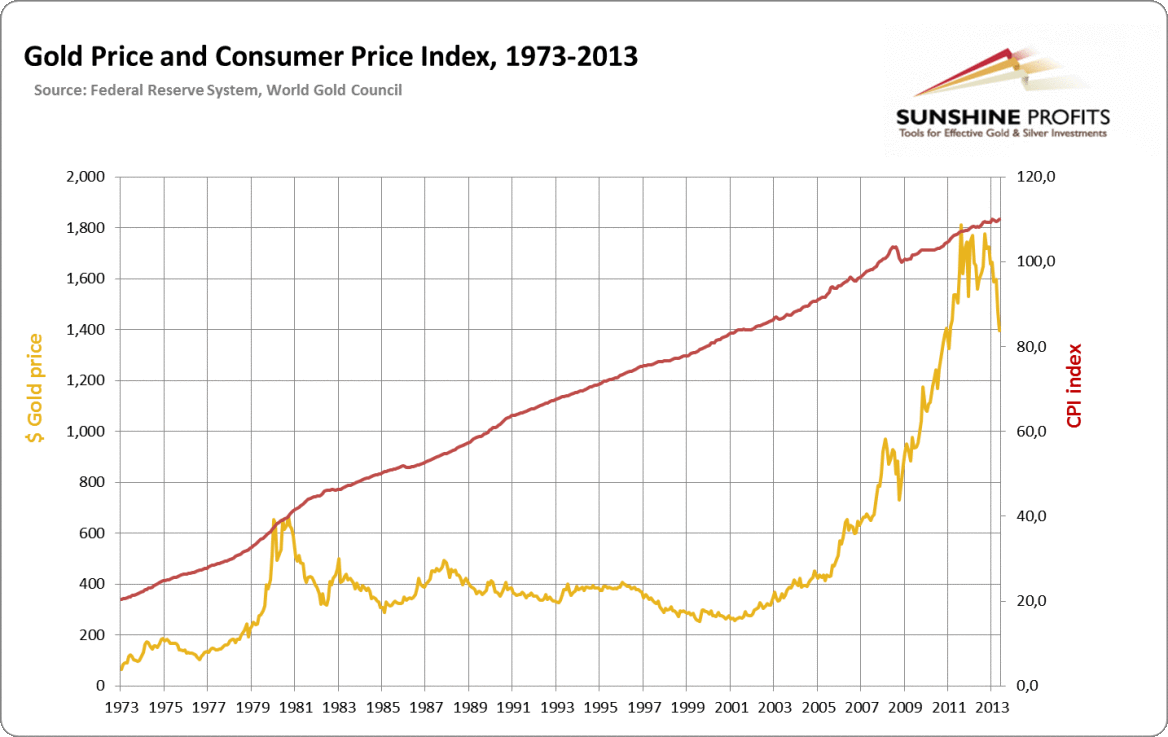
For the last 40 years the dollar was constantly losing its value (right scale) sometimes faster, sometimes slower. Yet gold appears to have its own way of reacting to this steady decline in the dollar’s purchasing power. Take as an example the case of the period between 1982 to 2002 when the dollar lost half of its value. During the same period gold did not gain 100% to compensate for inflation. It did not increase and did not even stay at the same level. In fact it lost its value. It was one of the worst inflation-hedges one could pick. It did not save your capital from inflationary policies. Worse, because it was inferior to the dollar putting your green paper currency in socks was a better choice than buying gold.
Two decades is not a short run. We do not take the highest gold price from the 1980s to prove the point. During those 20 years gold was losing its value faster than the dollar. Then things changed. For the next ten years the dollar lost its value, but there was a significant shift in the gold market. During that period of time, as we well know, gold gained tremendously. Even though the time period is not very long it can clearly confirm one thing: gold has its own separate market. Its value may be related to the inflation rate, but it is not a primary reason for major shifts in the value of gold. Simply put, there is more–much more. Historically gold is not a good inflation hedge (or precisely it can be in only certain circumstances).
The key to proper understanding of the gold market and more importantly – making a correct investment choice in the gold market – is getting rid of this popular notion about the yellow metals and admitting that gold will not necessarily save you from the inflation monster. Yet it can save you from something else: the endangered dollar system.
As mentioned earlier, the above is a part of the first Market Overview report that we have just published. The full version includes detailed discussion of the anti-inflationary investing vs. anti-system investing (when is gold exactly an inflation hedge?), physical gold production, mining costs, and more. We are generally fans of the try-before-you-buy policy, so we have already provided two parts of this month’s Market Overview this and last week. We are also posting this month’s Overview later than usually so that if you sign up for the monthly subscription, you’ll be able to read 2 monthly Market Overview reports in this period. The price for one month is $14.95, but we decided to lower it for the first month to $9.95. So, instead of one for $14.95 you get two for $9.95 – that’s a 67% discount for a premium publication. We’re not saying that you have to sign up but we highly recommend that you do and given the discount, it would be a waste not to take advantage of it. You can sign up here.
Thank you.
Matt Machaj, PhD
Sunshine Profits‘ Contributing Author
Sunshine Profits’ Gold & Silver Market Overview
He is a free market advocate, believes in personal liberty, responsibility, and believes that social power is a better alternative than government power. Personally he believes that intelligence is the most powerful thing in the universe and beyond. He is no fan of conspiracy theories, but likes to study conspiracy practices.
* * * * *
Disclaimer
All essays, research and information found above represent analyses and opinions of Matt Machaj, PhD and Sunshine Profits’ associates only. As such, it may prove wrong and be a subject to change without notice. Opinions and analyses were based on data available to authors of respective essays at the time of writing. Although the information provided above is based on careful research and sources that are believed to be accurate, Matt Machaj, PhD and his associates do not guarantee the accuracy or thoroughness of the data or information reported. The opinions published above are neither an offer nor a recommendation to purchase or sell any securities. Matt Machaj, PhD is not a Registered Securities Advisor. By reading Matt Machaj’s, PhD reports you fully agree that he will not be held responsible or liable for any decisions you make regarding any information provided in these reports. Investing, trading and speculation in any financial markets may involve high risk of loss. Matt Machaj, PhD, Sunshine Profits’ employees and affiliates as well as members of their families may have a short or long position in any securities, including those mentioned in any of the reports or essays, and may make additional purchases and/or sales of those securities without notice.

The speculative community has crushed the gold and silver price in the second quarter of this year. From a short term price perspective, the outlook for gold and silver is not too bright. On the other hand, investors who own the metal in PHYSICAL form (acting as their own central bank) have an ideal hedge against the increasing counterparty risk.
This week’s COT report (first chart gold’s report) provides an insight in the outlook of the precious metals. The COT report shows the futures positions of commercials and speculators. Their positions are important because those “paper markets” (COMEX and LBMA as the most significant ones) continue to dominate the price setting. Speculators include hedge funds in the “managed money” category in the reports.
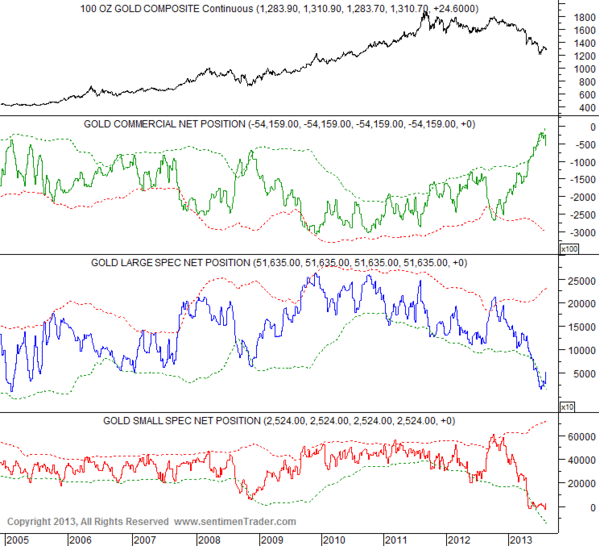
The chart shows that large speculators keep on increasing their net short position in gold while the commercials keep extending their net long position. Commercials are known for seducing speculators in one direction while simultaneously changing their own positions. Nevertheless, speculators have been in control over the past months with aggressive short bets. Besides, some analysts argue that the rise in long positions of commercials is due to hedging of gold miners, a common practice during gold’s bear market in the 90’s. It would imply that sentiment among speculators will be an important driver of precious metals prices going forward.
According to the latest Sentimentrader data, the sentiment vis-à-vis the metals remains at extreme levels. From a contrarian point of view, it could be interpreted as positive. But given the recent correlation between sentiment and prices, it is likely a bearish factor short and mid-term.
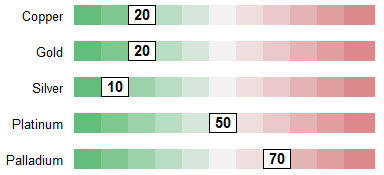
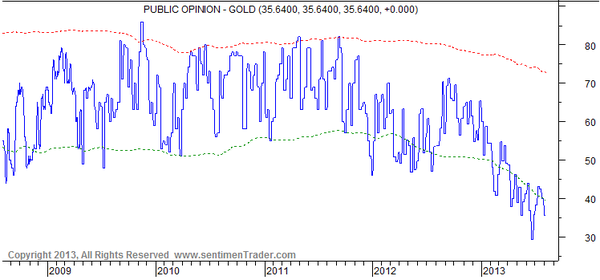
What is at the basis of this sentiment? In order to understand the arguments of the bears, it suffices to turn on a mainstream media channel. A recent commentary from a Wall Street pro on CNBC, Mr. Scaramucci, showed four reasons why hedge funds could continue to push the gold (and silver) price lower.
When analyzing the bearish arguments, we figured that every argument can basically be reversed to become a valid counter-argument. Why? In our opinion, it all depends on the time horizon and the fundamental difference between investing and trading. The following high level analysis makes our point clear.
Please note that our point is not to criticize trading. We just point to the fundamental difference between trading and investing. Traders do not necessarily take decisions based on fundamental grounds. Also, traders have a benefit in the fractional and leveraged system, which is the reason why they will never mention the monetary benefits of physical precious metals.
Bearish argument 1: Central bankers are exercising caution
The first point is related to inflation. It touches the most known benefit of gold, which is a hedge against inflation. The following quote comes from the CNBC interview:
“There’s a lot of very wealthy people that are going to own gold as a defensive hedge for what they’re fearing is that whole Weimar Republic thing, where either the Europeans or the United States aggressively prints money, where the multiplier effect kicks in on the banking side, and you get this out-of-control inflation,” Scaramucci said, referring to hyperinflation that occurred under the German democratic system in place between 1919 and 1933.
But Scaramucci says these gold bugs just aren’t doing their research. “If you read the minutes from the Federal Reserve, or if you look at the essays that Ben Bernanke just recently published, you will discover that your central bankers, particularly in the United States, understand this issue very well. And that’s one of the main reasons that gold has not worked in this environment.” The Fed minutes make clear that the Fed is keeping a close eye on inflation, and is keeping risk factors in mind. For instance, the latest Fed meeting minutes, from the July 18-19 meeting, note: “Although the staff saw the outlook for inflation as uncertain, the risks were viewed as balance and not particularly high.”
The obvious counter-argument?
The underlying assumption in the above statement is that the US central bank is kind of omnipotent. But what if that is not true and their policy will not bring the desired results? After all, they cannot justify their policy based on empirical results as the current money experiment is unprecedented in its scope and scale.
The fact is that the US is currently exporting their (monetary) inflation. Lots of the newly created dollars end up at foreign central banks rendering abroad currencies weaker. That is why the dollar is increasingly bypassed through trading agreement particularly by the BRICS (as we reported here, here, and here). Going forward, one should not exclude a scenario in which inflation stays within the US and price inflation picks up fast.
True, it is not visible on the horizon yet. But it is a looming risk which can materialize rather fast. History learns that inflation remains invisible longer than most expect but picks up faster than expected.
Bearish argument 2: Deflation has become a risk
The second point is related to disinflationary signs from the global economy which could, ultimately, lead to deflation. From the interview:
“What’s happening now is the specter of deflation is way, way, way more fearful to the central banking community than inflation,” Scaramucci said, “and gold typically works when there’s a devaluation of currency, or inflation.” As the Federal Open Market Committee noted in its July 31 statement: “inflation persistently below its 2 percent objective could pose risks to economic performance.” “In a deflation economy,” Scaramucci said, “gold is not going to work.”
The obvious counter-argument?
Central banks are scared to death about deflation. Japan’s fear for deflation resulted in the biggest monetary stimulus in history, beating helicopter Ben. What if central bank’s policies get out of control in their attempt to defeat deflation?
From another point of view, let’s assume that Western central banks will allow deflation. In such a scenario, gold will go down, but history has shown that it goes down to a LESSER extent than other assets (see Exeter’s pyramid). In such an environment, physical gold offers protection in a decline of purchasing power.
Bearish argument 3: The Fed won’t sell its bonds
The third point is related to the risk that the bond bubble will burst. From the interview:
“People are buying gold because they predict there’s a bond bubble,” he said. “And they predict that, at some point, the Fed is going to shed their $3.9 trillion balance sheet. But that’s not going to happen either.” He believes this incentive for the Fed to sell its bonds simply isn’t there. “The Fed’s duration on its balance sheet is only about seven years,” Scaramucci said. But “they’re a 100-year-old institution, they live inside a 237-year-old country, and there’s no reason to shed that portfolio. They’ll just let their portfolio unwind. And so the prediction here will be that gold prices will languish.”
The obvious counter-argument?
The US Fed is the most important buyer of domestic bonds. What if the market loses trust and pushes yields much higher, to such an extent that the Fed cannot control their own interventions? Higher bond yields (and hence lower bond prices) started to “spiral out of control” since May of this year. The US Fed’s chairman reaction on that was: “it got us puzzled.”
Longer term, our belief is that distorted markets because of central bank intervention will react violently. The precious metals selloff this year was due to the investing community’s perception of relative asset performance. Precious metals were simply the first shot across the board. With looming inflation and dollar debasement, precious metals will be back in favor longer term. That’s when a major price rise will be likely, at a comparable pace as the recent decline. Likewise, we expect other assets to be sold off hard as soon as they will fall out of grace.
Bearish argument 4: Economic growth would hurt gold
The fourth point is related to additional monetary easing as a response on economic growth.
To Scaramucci, holding gold has become a lose-lose proposition. “If the economy picks up, rates pick up, that’s bad for gold. If the economy doesn’t pick up, the Fed is going to be in exactly the position that it’s in now, which is effectively QE but no real money creation.” Simply put, while people thought quantitative easing would create gold-boosting mega-inflation, that simply hasn’t happened. So now, the risk remains to the downside—because rising rates make gold, which does not produce yield, even less attractive in comparison to bonds.
The obvious counter-argument?
On one hand, the gold price has risen between 2001 and 2008 without quantitative easing and with much higher interest rates as today. On the other hand, quantitative easing is about currency debasement, which is happening all around the world right now. The epicenter is in Japan and the US. The dollar is the best of all bad currencies.
The rationale for investing in (physical) gold is related to the monetary protection against the debasement of money.
Also, every marginal unit of economic growth needs an increasing number of units of debt. The effectiveness of debt is at all time lows. So more debt is needed to keep the economy going, not growing. That points to a continuation of the dilution of the value of money.
Conclusion
While the bearish arguments do make sense from a trader’s point of view in the short to mid-term, they do not take into account the fundamental monetary benefits of gold and the violent message of heavily distorted markets. The monetary crisis and financial turmoil in a centrally managed economy are starting to show their ugly head. Jim Rickards describes in Currency Wars how the previous two currency wars took 10 to 15 years to play out. If history is any guidance, the monetary crisis will be the most important fundamental driver for gold. But that’s not what is top of mind of traders, at least not yet.
About GoldSilverWorlds.com
A couple of years ago, we discovered something was fundamentally wrong in our economy. Between the spring of 2000 and 2009, we noticed a series of extreme but also conflicting events. For example, the two decade bull market in the global stock markets which should have ended in 2000, should have been replaced by a new wealth cycle. Instead, in 2007 a new peak was reached in the stock market, but in a non-natural way. The type of implosion that followed in 2008/2009, wasn’t a natural type of event. At the same time, while the price of several commodities have been increasing in a steady way, others showed literally price explosions. One of those commodities, gold, revealed such a steady and robust long term price chart, that it raised a very natural question: ”What is such a robust price chart signaling?”
Our personal and extended research showed that we were experiencing a new wealth cycle. In the last two decades of the 20th century, paper financial assets were the main source of wealth creation. But as it goes with all cycles in this world, the death of one cycle goes hand in hand with the birth of a new one. So we discovered that the first years of the 21st century brought about the birth of a wealth cycle that was centered around hard assets: gold, silver, grains, sugar, potash, rare earths, etc.
Interestingly, the paper financial world was still rising at the same time. In the light of the theory of wealth cycles, we thought that was not really possible …. until we understood the role of the governments. They were apparently not very happy with the ongoing evolution. A paradigm based on financial paper assets is the kind of world they like because they can control it. The real assets based paradigm by contrast, implies a less significant role for governments and Central Banks. It’s all about power and control, even if it means they need to fight a natural ongoing trend. That insight marked a milestone in our view on the world. We weren’t aware it was THAT bad.
By researching the different types of commodities, we discovered that gold and silver had some special values. The most striking one, is integrity! Gold cannot lie, is what we wrote about it. Furthermore, it’s the only asset that can store wealth in a universal way, outside the financial system. During the exceptional implosion of the financial world in 2008 / 2009, we understood that gold was the ultimate store of value: despite it’s price decrease, it was still protecting wealth. The safe haven characteristic of precious metals is historically an important one, although it seems that the world forgot it over the past few decades.
By talking to ordinary people like friends and families, we discovered that most of us consider holding gold or silver as something “exotic”, something “mythical”. That was the final trigger for the birth of GoldSilverWorlds. As we became convinced that gold and silver were decisively going to continue their uptrend and that most people were not aware of the values of the precious metals, we wanted to contribute in a positive way to our society. The ultimate message of gold and silver being “safe havens” which protect our wealth, is a fundamental one for everyone of us to understand. It becomes even more important in a world where governments, central planners and banks will do everything they can to maintain their power. Their extremely dangerous monetary policies result in immense amounts of debts, that sooner rather than later will result in wealth destruction. The longer we wait, the worse the effects. Ordinary and hard working people will pay part of the bill as well. This attitude is simply immoral.
GoldSilverWorlds has the intention to spread the message about the real benefits of gold and silver in a simple way that everyone of us can understand. GoldSilverWorlds helps people understand how to invest their personal or professional wealth, where they can do so and what to avoid when doing so. Those are messages that are not told by mainstream media, sadly enough. Because of the internet, we can help each other as indidivuals, so let’s make use of it !



Gold is trading $18 higher at 4pm PST in London Trading @ 1331.40, Silver opens up .50 cents higher and is at the moment of this writing trading over $21.00 @ 21.05. Trading in New York at 4pm PST is somewhat delayed but last quotes at time of writing are 1331.20 and 20.94.
One reason for the increase is the holdings in the biggest bullion-backed exchange-traded product SPDR expanded for the first time since June.

Keith Schaefer talks about prospering in the Energy Markets Worldwide & about LNG bonanza that is happening in Northern BC during the first 1/2 hour of Money Talks below. Keith is the author of the Oil & Gas Investments Bulletin
{mp3}mtaug10lead1{/mp3}
Ozzie Jurock, a master himself answers some very pointed questions about mastering Real Estate, one of the great fortune making markets .
{mp3}mtaug10hour1{/mp3}
Victor Adair stands in as this weeks Money Talks host as Michael Campbell is taking a well deserved day off.
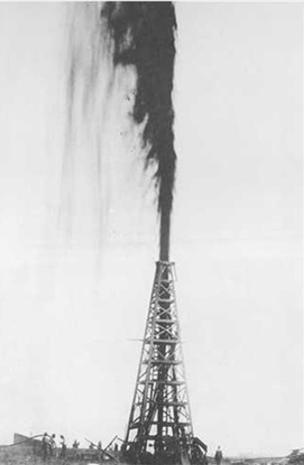 Spindletop–the gusher on the right marked the emergence of the oil industry at a time when the automobile and other industries were experiencing rapid growth.
Spindletop–the gusher on the right marked the emergence of the oil industry at a time when the automobile and other industries were experiencing rapid growth.
Spindletop marked the birth date of the modern petroleum industry. At 100,000 barrels of oil a day, the gusher tripled U.S. oil production overnight. Some of the companies chartered to exploit the wealth of Spindletop, such as Gulf Oil and Texaco, are part of today’s Chevron Corporation.
….more on Spindletop HERE

The Bureau of Labor Statistics July payroll employment increases where +162,000 and unemployment rate edged down to 7.4%
But as a share of jobs, full-time positions have shrunk by 4 million since the beginning of the recession. Don’t let the BLS fool you. If they’re being replaced at all, it’s with part-time jobs.
Peter Morici, an economics professor, explained the reason for the shift away from full-time positions. Businesses “are finding health insurance too expensive to provide [full-time] employees,” he told The New American, “and if they cut down to part-time workers, turning three jobs into four, they avoid all that… Some folks will have to work two jobs to make ends meet, and they still don’t get health care.”












